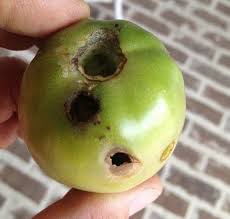The Tomato’s Silent Scream: What That Mysterious Hole Is Trying to Tell You
You’ve patiently watched over your tomato plants like a hawk. Watered them. Fed them. Shielded them from storm and sun. And just when the fruit blushes red with promise, you spot it: a puncture, a gash, a hollow wound bored deep into the side of a tomato that should’ve been perfect.
It’s easy to dismiss as random damage. But make no mistake—this is no accident. It’s a signal, a message carved into the flesh of your crop. The garden is speaking. Are you listening?
What’s Really Behind That Hole in Your Tomato?
Finding a hole or blemish in your tomatoes is a rite of passage for many home gardeners—but knowing what kind of damage you’re seeing can reveal what’s really going on behind the scenes.

1. The Chewed-Out Crime Scene
If the damage looks rough and ragged, as though something took a hungry bite, you’re likely dealing with a garden pest. The main suspects include:
Tomato hornworms: These camouflaged caterpillars can devour entire leaves and burrow into fruit.
Stink bugs: They pierce the skin, causing hard white spots inside the tomato.
Beetles and slugs: Known for leaving irregular holes and sometimes slime trails.
Birds and squirrels: Especially fond of ripe tomatoes, often pecking a hole or tearing through the side.
Look for signs like frass (insect droppings), slimy trails, or missing foliage nearby to help narrow down your culprit.
2. A Flaw From Within
Not all tomato wounds are caused by invaders. Some originate from within the plant itself:
Blossom End Rot: A dark, sunken patch at the bottom, caused by calcium imbalance and inconsistent watering.
Splitting or Cracking: Usually the result of a sudden change in moisture (e.g., heavy rain after dry conditions).
Sunscald: Pale, papery spots where intense sunlight has damaged the fruit.
These aren’t contagious or caused by pests, but they do signal that your plant is under stress—and may need more consistent care.
Should You Still Eat It?
If the tomato has only a small hole or scar, no visible mold, and smells normal, it’s usually fine to eat after cutting away the damaged section.
But if you notice:
A sour or fermented odor
Soft, mushy spots near the damage
White or green mold
…then it’s best to toss it. Better safe than sick.
How to Protect Your Crop Going Forward
Now that you can read the signs, here’s how to defend your harvest:
🌿 Practice garden hygiene: Remove fallen fruit and debris, which attract pests and harbor disease.
💧 Water consistently: Uneven moisture causes many internal fruit issues. Use mulch to help retain soil moisture.
🪴 Interplant deterrents: Herbs like basil, marigold, and mint can help repel insect pests.
🕸 Use netting or cages: Physical barriers can keep out birds, squirrels, and large insects.
🧪 Inspect daily: The earlier you catch a problem, the easier it is to manage. Check under leaves and along stems for pests.
Final Thoughts: Reading the Fruit’s Warning Signs
Every blemish on your tomato is a clue. It might tell you a hornworm crept in under the radar. Or that your plant is thirsty, overfed, sunburned—or just plain stressed. These aren’t just imperfections; they’re insights.
By learning the language of your garden, you evolve from caretaker to investigator—one who can read the story etched into every fruit. Armed with knowledge and attention, you’re well on your way to harvesting tomatoes that are as flawless as they are flavorful.
Because sometimes, growing food isn’t just about sunshine and soil—it’s about listening to what your plants are trying to tell you.
